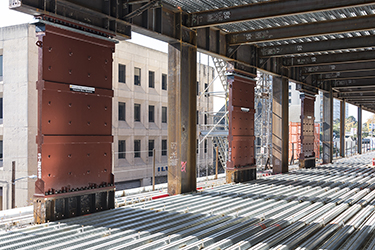|
Subscribe / Renew |
|
|
Contact Us |
|
| ► Subscribe to our Free Weekly Newsletter | |
| home | Welcome, sign in or click here to subscribe. | login |
Construction
| |
 |
February 27, 2020
Integrated project delivery offers risks and rewards for team members
Degenkolb Engineers

Salisbury
|

Love
|
After more than 10 years working on integrated project delivery (IPD) teams, Degenkolb Engineers has learned many lessons. As IPD becomes more prevalent and accepted by owners as a viable project delivery process, it’s helpful to understand the strengths of the process.
The Lean Construction Institute defines IPD as “a project delivery approach that integrates people, systems, business structures, and practices into a process that collaboratively harnesses the talents and insights of all participants to reduce waste and optimize efficiency through all phases of the project, from early design through project handover.”
IPD requires a change in thinking of the entire design and construction team. By bringing the entire team together from the beginning stages of the project, they can consider all aspects in every conversation.
Degenkolb Engineers has provided structural engineering services for more than $4 billion in IPD and lean-driven health care and education projects. This experience includes:
• Sutter Health’s California Pacific Medical Center, Van Ness Campus (CPMC Van Ness): 13-story, 1 million-square-foot acute care hospital with 247 patient beds, diagnostic and treatment centers, and subterranean parking.
• Sutter Health’s California Pacific Medical Center, Mission Bernal Campus (CPMC Mission Bernal): Seven-story, 215,000-square-foot acute care hospital with 120 patient beds, operating suites, expanded maternity ward and emergency room, and acute geriatric unit.
• Sutter Health’s Alta Bates Summit Medical Center Merritt Tower: 11-story, 250,000-square-foot acute care hospital with 238 patient beds and inpatient acute rehabilitation treatment center.
• University of California, San Francisco (UCSF) Joan and Sanford I. Weill Institute for Neurosciences: 274,000-square-foot research facility for psychiatry, neurology, neurosurgery, and basic neuroscience with desktop research, clinical research and clinical care space.
• University of California, San Francisco (UCSF) Research and Academic Building at Zuckerberg San Francisco General Hospital and Trauma Center: Five-story, 175,000-square-foot laboratory research and academic facility.
Team culture
A strong IPD requires active facilitation and participation. A significant investment of time is needed to build the individual relationships and culture of the team as a whole.
Strong relationships and trust create psychological safety and collaboration, allowing the team to take risks. The environment created must allow all ideas to come to the table.
A common theme heard amongst our IPD project teams is staffing continuity.
“Teams must have a process for onboarding and offboarding team members. There must be a commitment to maintaining continuity of project knowledge and team culture,” said Ray Pugliesi, Degenkolb senior principal and project manager for the UCSF Weill Institute. “Including design and preconstruction personnel needs to be supplemented by construction superintendents and foremen who will be out on the project site. Field staff are best equipped to tell you if your design is feasible for construction.”
IPD is an intentional process and requires agreement from all parties. There are differing opinions on whether IPD can be executed with traditional contracting methods or if an Integrated Form of Agreement (IFOA) is needed.
IFOA is a tri-party agreement between the owner, contractor and architect. The IPD IFOA shares the project risks and rewards proportionate to team member’s financial and technical involvement. To date, our experience centers around IFOA-based IPD projects.
Pulling together
The CPMC Mission Bernal project team encountered a difficult situation late in construction.
“All of our target costs started creeping up and our contingency started to disappear,” explained Carrie Mitchell, Degenkolb principal and project manager for structural design.
The team pulled together and created a new plan and schedule for the entire project to stabilize key project indicators.
“I don’t think the team would have pulled together without the IFOA,” she said. “The IFOA encouraged the team to pull together, without pointing fingers, saving approximately 85% of the project’s profit. It’s imperative to keep project goals top of mind for the entire team every week.”
Wayne Low, Degenkolb senior principal and project manager for structural design for Sutter’s Alta Bates Summit Merritt Tower, participated in an IPD research study at UC Berkeley.
“In our research we found that it only takes one partner to send the whole project awry,” Low said.
Not all parties of the design and construction team participated in the IFOA for one project. One team member didn’t participate and had a large scope of construction responsibilities and fell behind on delivery. This team member was unresponsive to the team, causing constraints for the project as a whole.
“People always put their own interests first if they’re not financially tied together,” Low said.
IPD encourages team members to bring all possible design and construction solutions to the table and to keep all of these options open until the team makes final design decisions.
For Sutter Health, the ability of their facilities to function after a large earthquake is key. At CPMC Van Ness, the team explored traditional code-based structural design and looked at developing technologies and practices.
Structural engineers proposed a hybrid steel moment-frame design incorporating viscous wall dampers. Developed in Japan over the past 30 years, viscous wall dampers absorb strong movement and reduce overall stress on the building.
CPMC Van Ness is the first building in the United States to use viscous wall dampers. The wall dampers absorb about 90% of the energy from an earthquake and have the added benefit of augmenting the strength of the building. Without the wall dampers, the hospital would have required up to 60% more steel. Factoring in the cost of the wall dampers with structural steel, the design saved 25% of the total cost of the building’s structural steel.
While IPD is still relatively new to design and construction, it is imperative to understand the process as a whole, the time and commitment needed by each team member, and the importance of shared risk and reward.
Kenda Salisbury and Jay Love are Degenkolb engineers.
Other Stories:
- Hospital projects in rural areas face extra obstacles
- UW’s new health sciences building will be a hub for 21st-century care
- Good design takes some stress out of visiting the hospital
- Building out this new hybrid OR was no simple operation
- Hospitals giving way to other care options as providers look to cut costs
- CHP systems: a powerful energy-saving tool for hospitals
- A look inside the Cure Factory, Seattle Children’s new cell therapy lab
- Fire dampers: one more way hospitals can save lives
- Health care could look a lot different in 2040, so get ready
- Here’s what’s in store for health care in the Northwest
- How welcoming design can improve outcomes for patients — and staff



